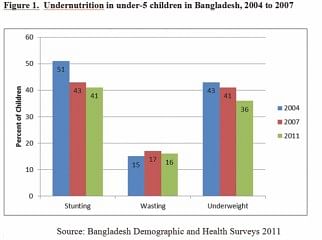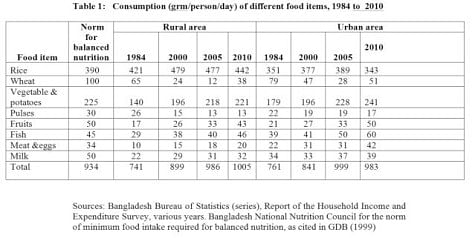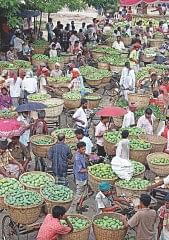Achievement and challenges
One of the fundamental rights of the citizens stipulated in the Bangladesh Constitution is food security for all. Food security exists when all people, at all times, have access to sufficient, safe and nutritious food to maintain healthy and productive lives. The key elements of food security are: a) availability of enough food from domestic production and/or imports to meet the demand, b) access of the food to all people at all times through enough incomes and affordable prices, c) proper hygiene and sanitary practices and safe water for utilisation of food to have optimum impact on health and nutrition, and d) a regulatory framework in place and its proper implementation for controlling contamination to ensure food safety.
Availability of food
In view of repeated experience of severe hunger and famine, food security in Bangladesh has long been synonymous with achieving self-sufficiency in rice, the dominant staple food. The Bangladesh economy has made respectable progress in rice, tripping production from 11 million tonnes in 1971 to 33 million in 2012. The per capita rice production has increased substantially over the level at independence. The growth of production was achieved by fast adoption by farmers of higher yielding crop varieties developed by scientists, supported by rapid expansion of irrigation infrastructure through private investment in tube wells.
Bangladesh used to receive substantial amount of wheat, the secondary staple food, as food aid from developed countries. Commercial import of wheat has however increased despite growth in domestic production till the 1990s, mainly due to the discontinuation of food aid and stagnation of domestic production after a rapid growth in the 1980s. The import has recently exceeded three million tonnes. It appears that even if Bangladesh achieves self-sufficiency in rice production or becomes a rice exporting country, the import of wheat will continue.
Notable progress has been achieved in the production of potatoes and vegetables. The growth has been particularly impressive in the last decade. The major problem faced by potato and vegetable production is the volatility in prices leading to large year to year fluctuations in production. The production of most other food crops – pulses, oilseed and sugarcane – has either remained stagnant or has declined. The production of oilseeds has picked up in recent years due to favourable prices, some progress in the development of higher yielding varieties, and identification of favourable agro-ecological niche. The dependence of Bangladesh on the world market for the availability of pulses, edible oil and sugar and milk has been growing, along with wheat.
Bangladesh has rich biological resource base for fish production. In terms of nutrition, fish occupies a significant position in the dietary habits of the people. The growth in fish production was sluggish in the 1970s, it picked up in the 1980s, and was very rapid (7 percent per year) in recent years due to the expansion of pond aquaculture. Entrepreneurs have started converting low-lying lands into fish ponds and engaging in highly productive and profitable pond aquaculture. The prices of cultured fish such as tilapia, koi, and pangash have declined compared to other fish, and have been within the reach of low income consumers.
The growth in the production of meat and milk has remained unsatisfactory despite the expansion of the poultry industry. With economic progress the demand for animal products has been growing fast. The growth in livestock and poultry farming is constrained by lack of feed, risk imposed by avian flu and other animal diseases, and poor processing, storage and marketing infrastructure.
Access to food
In a market economy, the access to food depends on four elements: a) production-based element that depends on ownership of land, b) trade-based entitlement that depends on market prices of food, c) labour-based entitlement that depends on the employment and wages, and d) transfer-based entitlement that includes gifts, remittances from relatives, and relief and subsidies obtained from the government. The ability of the household and the people to access food is the outcome of the complex operation and interactions of all these elements.
In Bangladesh, 70 percent of the people live in rural areas where agriculture is the major occupation. Almost 60 percent of the rural households are engaged in farming. The farming household can access their food from self-production and/or trading the surplus with other foods available in the local market. But the landownership is unequally distributed, and so is the access to food from self-production. Almost 30 percent of the households do not own any land and another 30 percent own only up to half an acre. Such tiny landownership is insufficient to meet the food needs of four to five-member households, whatever advanced technology the farmer use. A tenancy market is in operation, which provides access to land to landless and marginal landowners for farming. But the terms and conditions of tenancy do not favour tenants. So, a large proportion of marginal farmers go the market to access food as their own production (after payment of rent and interest for loans) is inadequate to meet the household needs.
The dominant determinant of access to food is obviously the level and the growth of income. In Bangladesh, the per capita income remained almost stagnant till the end of 1980s due to slow growth of GNP and high population growth. The income growth per year has accelerated since 1990, reaching 6.5 percent in recent years. Bangladesh has also achieved respectable progress in population control. But, the income is highly unequally distributed and the disparity has been growing. As a result nearly one-third of the people still live below the poverty line, with inadequate income to access food from the market.
An indicator often used to assess the capacity of the poor to access food from the market is the level and trend in real wages. This indicator shows that since the mid-1990s there has been a favourable trend in the income of the households who depend on selling labour in the market, such as agricultural wage labourers, transport operators and construction workers. The Land Reform in 1984 stipulated a minimum wage equivalent to 3.5 kg of rice at the prevalent market price. The rice equivalent wage had increased from about three kg in 1990 to nearly 8 kg in 2011. The only low group who have not been able to increase their real income are industrial labourers, particularly the unskilled workers in the garment industry and the fixed wage earners in the public sector.
The hike in food prices after the food crisis in 2007 has had a negative impact on the real wages and access to food. Sharp increase in food grain prices significantly lowers the real income of poor households who spend over half of their income on staple food. At the same time the instability in producer prices increases risks and uncertainty, and discourages the subsistence farmer to invest in agriculture. The volatility in food prices remains an issue for achieving seasonal and temporal stability in food security.
 Bangladesh is often at the mercy of natural calamities such as floods, droughts and cyclones. Riverine Bangladesh also witnesses frequent land erosion causing thousands of people to lose their land every year. Despite the gains achieved by Bangladesh in augmenting availability of staple food, a safety net programme is essential to insulate the poverty stricken population from chronic as well as temporary food insecurity that results from external shocks. A number of food safety net programmes are in operation in Bangladesh, each with its own specific objectives and target population. These include test relief, Vulnerable Group Feeding, Vulnerable Group Development, Food for Work, Employment Guarantee Scheme, etc. A number of social protection programmes such as vulnerable group feeding, allowance for destitute women, and old age pensions have also been introduced to support food security of the extremely needy people.
Bangladesh is often at the mercy of natural calamities such as floods, droughts and cyclones. Riverine Bangladesh also witnesses frequent land erosion causing thousands of people to lose their land every year. Despite the gains achieved by Bangladesh in augmenting availability of staple food, a safety net programme is essential to insulate the poverty stricken population from chronic as well as temporary food insecurity that results from external shocks. A number of food safety net programmes are in operation in Bangladesh, each with its own specific objectives and target population. These include test relief, Vulnerable Group Feeding, Vulnerable Group Development, Food for Work, Employment Guarantee Scheme, etc. A number of social protection programmes such as vulnerable group feeding, allowance for destitute women, and old age pensions have also been introduced to support food security of the extremely needy people.
The present government has given high priority to the safety nets for ensuring food security. Currently nearly 2.2 percent of the GDP are allocated for safety nets and social protection. The evaluation of the programmes however revealed several limitations; a) large overheads due to operation of a large number of small programmes by different ministries often with the same objectives, b) improper targeting of beneficiary households, and c) leakages in implementation. The only exception is the employment guarantee programme during the slack seasons, which appears to be self-targeted as the beneficiary has to provide manual labour.
 Utilisation of food and nutrition security
Utilisation of food and nutrition security
The acceleration in economic and agricultural growth has made a positive impact on the the diversity of food intake away from the rice and vegetable based diet in favour of quality food. The change in per capita consumption of different items in the food basket for the rural and urban people, as estimated by the Household Income and expenditure surveys (HIES) of the BBS, are reported in Table 1. It may be noted that the per capita consumption of rice and wheat has been declining, while the consumption of vegetables, fruits and fish and meat has been growing. For rural areas the consumption of rice has declined from the height of 175 kg per person per year in 2000 to 161 kg in 2010, a decline of about 1.4 kg per year. For urban areas, the consumption of rice and wheat together has declined from 155 kg per person per year in 2000 to 140 kg in 2010, a decline 1.5 kg per year. During 2000 to 2010, the consumption of meat has increased by one-third for rural
areas and by 40% in urban areas.
However, the level of consumption of other food items, hardly meets the requirement for balance diet as specified by the National Nutrition Council and FAO. The numbers in Table 1 shows the average level of consumption has reached the adequacy level for rice and vegetable, and about to be reached for fruits and fish, but serious deficiency persists for quality food such as pulses, oil, and livestock products.
The average numbers also masks serious inequality in the distribution of consumption across the income scale. While the richer sections of the society are being able to gradually reduce their cereal intake and diversify their diet, the poor still have an unmet demand for rice. For all the other food items, consumption for all income groups have increased, marginally for the bottom 40 percent but substantially for the top 20 percent. A recent IFPRI study shows that nearly 20 percent of the population is still calorie deficient and the gender disparity in calorie intake still persists. The 2011 report of the Food Security and Nutrition Surveillance project implemented by the Helen Keller International (HKI) and BRAC University shows that a quarter of the households has go without a meal a day or to reduce the intake of food a number of days during a month.
Bangladesh has made significant progress in reducing undernutrition for the children (see Figure 1). The prevalence on underweight children for their age declined from 60 percent in 1990 to 36 percent in 2011, and is on track for achieving the target set by the Millennium Development Goals (MDGs). However, progress in reducing stunting, the indicator of chronic malnutrition, shows a less encouraging picture. The level is still about 41 percent, much higher than countries in sub-Saharan Africa. Over 2007 to 2011, the stunting declined by only two per cent points. Stunting affects the cognitive ability and the immunity of the children from diseases. The prevalence of wasting, an indicator of current nutritional status, remains at an alarming level of 15 to 17 percent, with very little improvement over time.
Low birth weight among Bangladeshi infants is among the highest in the world, ranging between 20 and 22 percent. The nutritional status of women shows a better trend. The proportion of women with chronic energy deficiency has declined from 52 percent in 1997 to 25 percent in 2011. But the prevalence of obesity among women is also emerging as a public health issue. The hidden hunger, the insufficiency of vitamin A, iron and zinc in the diet that causes major diseases such diarrhoea and anaemia and poor eye sight is still a major health issue.
Challenges for achieving food security
The main challenge for achieving and sustaining food security comes from continuing growth of population. The progress in reducing population growth, from 3 percent per year at independence to about 1.3 percent now, is laudable. But the population is still increasing by 1.8 million every year. Rice production has to increase by four lakh tonnes every year to meet the need for staple food for the growing population. The increase in domestic production at that rate would be difficult due to several supply side factors.
The arable land has been shrinking by 0.6 percent every year due to demand from housing and industries, and infrastructure, as well as loss of land from river erosion. With global warming and climate change, another one-sixth of the land may be submerged with brackish water due to rising sea levels. The on-going climate has made the monsoon more erratic, raising risks in food production. The soil fertility has been declining due to overexploitation of soil nutrients, and imbalanced use of fertilisers. The ground water aquifer has been going down from over-mining for irrigating boro rice. The low hanging fruits with regards to irrigation expansion and technological progress have already been harvested. Due to all these factors the potential for further increase in production is getting limited.
There are some silver linings however. As mentioned earlier, with economic progress people now have capacity to access a diversified diet with less rice and more quality food. The per capita consumption of rice has been declining by almost 1.5 kg per person per year. Japan and South Korea had the same experience during their process of economic development. It seems that we have reached the stage of economic growth when people are going to gradually reduce the consumption of rice with higher intake of other food. So, despite some growth of population the demand for rice may not grow much further.
Rice production can further be increased with intensification of land use with the use of shorter maturity varieties and adoption of submergence tolerance, drought tolerance, and saline tolerance varieties in adverse agro-ecological environments such the southern coast and the Haor areas in the Northeast, and the flood-prone areas in the river and coastal chars. The diffusion of hybrid rice could further increase the rice yields, and the yield gaps of existing varieties could be reduced with the adoption of finer crop management practices, such as the System of Rice Intensification (SRI). Indeed, with all these potentials exploited, Bangladesh could become a rice exporting country.
The more difficult challenge is accelerating the growth in the production of non-rice foods, such as pulses, oils, fish and animal products, whose demand has been growing fast with economic prosperity. We must reduce the growing import dependence of food to insulate the domestic market from the volatility of the world market. The R&D system must find ways to fit in pulses and oilseeds in the rice-based system. The vast potential for increasing fish production from the intensive use of the flood plains must be explored. Women are already heavily engaged in homestead based vegetable and fruit production, and subsistence based poultry and animal farming. The potential is large in this area. Women farmers should be supported with easy access to knowledge of improved technology and disease management, supply of quality seeds, and access to finance at easy terms. Private sector should have the enabling environment to link farmers to markets with expansion of processing and storage facilities and removing constraints in the value chain.
Bangladesh has yet to achieve comprehensive food security that resolves the problems of inadequate food intake and chronic malnutrition among poor people. Solving these problems will require concerted action by the government, the private sector and individual households. Continuous efforts need to be made in developing and diffusion of improved crop varieties and natural resource management to generate adequate supply of food to meet the needs of the growing population. A more efficient public food grain distribution system can make a significant contribution to the food security of vulnerable households who lack means to access food. Appropriately targeted income transfers, credit programs and insurance mechanisms in times of crisis may generate high payoffs in reducing poverty and improving food security. These interventions should be part of a broader social protection strategy that is both cost-effective and comprehensive in coverage.
The writer is Exective Director, BRAC.


 For all latest news, follow The Daily Star's Google News channel.
For all latest news, follow The Daily Star's Google News channel. 







Comments